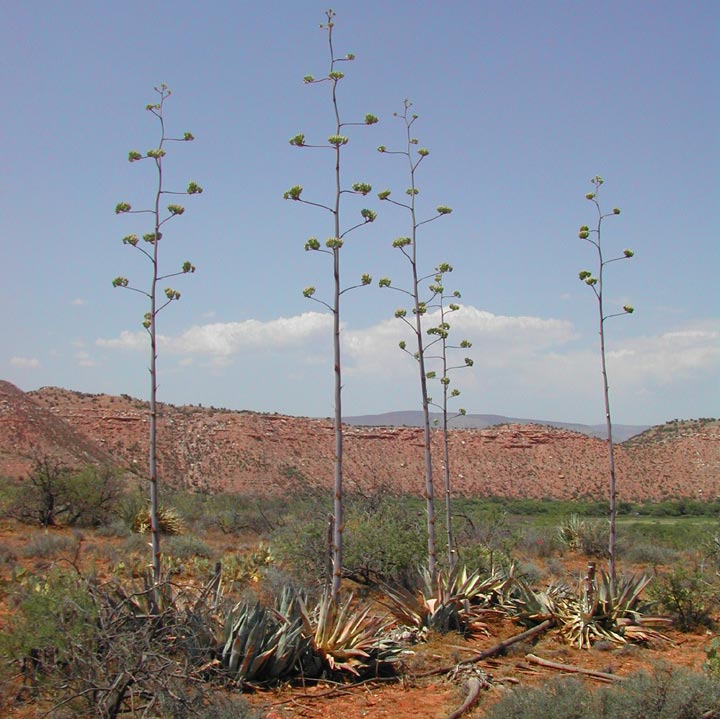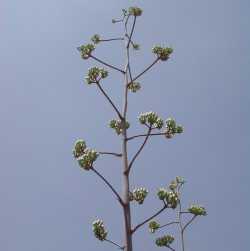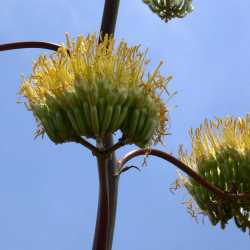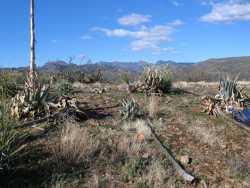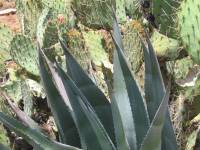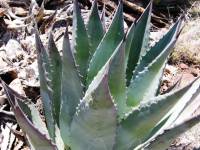
|
|
|
|
Family: Asparagaceae
Tonto Basin agave, more...Tonto Basin Century-Plant, New River agave
|
Plants acaulescent, freely suckering; rosettes solitary to cespitose, 9-10 × 9-10 dm, open. Leaves erect or erect-ascending, 50-63(-73) × 7.5-9 cm; blade glaucous-gray to -bluish, cross-zoned, lanceolate or oblanceolate, rigid, adaxially concave, abaxially convex; margins straight or repand, armed, teeth single, well defined, 3.5-5 mm, 1-3 cm apart, interstitial teeth (3-)6-12, mostly along distal 2/3 of margins; apex conspicuously incurved, spine brownish gray, slender, 2.8-3.5(-4.9) cm. Scape 4.5-6 m. Inflorescences broadly paniculate, not bulbiferous, open; bracts persistent, triangular, 1-5.5 cm; lateral branches 12-17, horizontal, comprising distal 3/5-5/8 of inflorescence, longer than 10 cm. Flowers 14-20 per cluster, erect, 4.7-6.7(-7) cm; perianth cream, tinged with light green, tube not shallow, campanulate, 11-16 × 11-16 mm, limb lobes persistent and often leathery during and after anthesis, spreading, unequal, 9-18 mm, apex flushed with maroon; stamens long-exserted; filaments inserted at 1 level ca. mid perianth tube, erect, yellow, 3-5.3 cm, apex flushed with maroon; anthers yellow, 11-20 mm; ovary 2.1-2.9 cm, neck slightly constricted, 1-3.5 mm. Capsules not seen. Seeds unknown. Flowering early summer. Gravelly places with desert scrub, rarely in chaparral or pinyon-juniper woodlands; of conservation concern; 700--1600 m; Ariz. Agave delamateri is known only from about 90 individual clones and always in association with Mogollon or Salado settlement features. The plant is probably a cultivar derived from A. palmeri or a closely related taxon by pre-Columbian people. Agave delamateri hybridizes with A. chrysantha, acting as a pollen donor.
Plant: perennial scapose herb; Rosettes caespitose, ca. 1 m high, 1 m broad Leaves: numerous, 50-63(-74) cm long, 7.5-9 cm wide, broadest near or above middle, lanceolate to oblanceolate, acuminate, erect-ascending, becoming inwardly arcuate at apex, deeply concave above, thick and convex toward base, easily cut, bluish-gray glaucous with purple-maroon tinge and green cross-banding, the margins straight to repand; teeth somewhat variable, dark brown to gray, the larger ones 3.5-5 mm long, usually reflexed, firmly attached, 1.5-11(-40) mm apart; interstitial teeth (3-)6-12 on upper - of leaf margin; terminal spine 2.8-3.5(-4.9) cm long, slender, openly grooved above, brownish-gray, decurrent for 9-14 cm to upper teeth INFLORESCENCE: with scape 4.5-6 m tall, broadly paniculate, open, of 12-17 widely spaced, long horizontal branchlets in upper 3/5-5/8 of flowering stalk, the stalk thick, purple-maroon Flowers: in clusters of 14-20, 47-67(-70) mm long, durable, with a strong musky but sweetish fragrance at anthesis; tepals persistently erect, clasping the filaments, becoming leathery or wood-like with age, unequal, light cream-green, the outer ones ovate-lanceolate, 14-18 mm long, 6-7 mm wide, with maroon-rust rugose hooded tips, the inner ones broadly lanceolate, 9-15 mm high, 5-7 mm wide, strongly keeled, the tips slightly hooded; filaments 30-53 mm long, inserted equally 6-8 mm above base of tube, maroon, the anthers 11-20 mm long, bright yellow; ovary slightly angled longitudinally, 21-29 mm long, thick, stout, with slightly constricted neck 1-3.5 mm long, cream-green, the style 35-49 mm long when stigma is receptive, cream flecked with maroon; floral tube 11-16 mm long, 11-16 mm broad, bulging at base of tepals, light cream-green Fruit: capsules Misc: -Usually in vicinity of major drainage systems on open hilly slopes in desert scrub, rarely in chaparral or juniper-grassland; 700-1550 m (2350-5100 ft); Jun-Jul REFERENCES: Hodgson, Wendy. 1999. Agavaceae. Ariz. - Nev. Acad. Sci. 32(1). FNA 2003 Common Name: Tonto Basin century plant Duration: Perennial Nativity: Native Lifeform: Succulent General: Perennial scapose succulents, rosettes growing as individuals or in clusters, 90-100 cm across. Leaves: Growing erect, 50-60 cm long by 7.5-9 cm wide, blades smooth and bluish-green, curving inward, along its length and at its tip, toothed along outer margins with distinct teeth, freely suckering. Flowers: On panicles, 14-20 per cluster, clusters borne on a stalk 4.5-6m tall, flowers bell-shaped, cream colored to light green, with long-exserted stamens, arranged in panicles and subtended by triangular, persistent bracts. Also borne on lateral branches (up to 17). Fruits: Capsule, but uncertain if it is a sterile hybrid or not. Ecology: Found in gravelly areas in desert scrub, chaparral, or pi-on-juniper woodlands from 2,500-5,500 ft (762-1676 m); flowers in early summer. Notes: According to FNA, this species is very rare and only about 90 individuals are known, found in regions where the Mogollon or Salado peoples had early settlements. Thought to originate as a cultivar from A. palmeri produced by pre-Columbian peoples. A .delmateri is known to hybridize with A. chrysantha. Ethnobotany: Specific use of species unknown, but uses for the genus include using the whole plant as food, and leaves as fiber to make clothing, tools, rope, and sandals. Etymology: Agave is from Greek agauos, admirable, noble, while delmateria is named for Rick DeLamater an ASU graduate student who rediscovered this rare agave 60 years after it was originally found. Synonyms: None Editor: LCrumbacher, 2011 |
This project was made possible in part by the Institute of Museum and Library Services [MG-70-19-0057-19].
Powered by Symbiota

